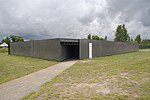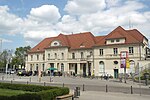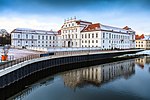Sachsenhausen concentration camp

Sachsenhausen (German pronunciation: [zaksn̩ˈhaʊzn̩]) or Sachsenhausen-Oranienburg was a German Nazi concentration camp in Oranienburg, Germany, used from 1936 until April 1945, shortly before the defeat of Nazi Germany in May later that year. It mainly held political prisoners throughout World War II. Prominent prisoners included Joseph Stalin's oldest son, Yakov Dzhugashvili; assassin Herschel Grynszpan; Paul Reynaud, the penultimate prime minister of France; Francisco Largo Caballero, prime minister of the Second Spanish Republic during the Spanish Civil War; the wife and children of the crown prince of Bavaria; Ukrainian nationalist leader Stepan Bandera; and several enemy soldiers and political dissidents. Sachsenhausen was a labour camp, outfitted with several subcamps, a gas chamber, and a medical experimentation area. Prisoners were treated inhumanely, fed inadequately, and killed openly. After World War II, when Oranienburg was in the Soviet Occupation Zone, the structure was used by the NKVD as NKVD special camp Nr. 7. Today, Sachsenhausen is open to the public as a memorial.
Excerpt from the Wikipedia article Sachsenhausen concentration camp (License: CC BY-SA 3.0, Authors, Images).Sachsenhausen concentration camp
Straße der Nationen,
Geographical coordinates (GPS) Address Website External links Nearby Places Show on map
Geographical coordinates (GPS)
| Latitude | Longitude |
|---|---|
| N 52.765833333333 ° | E 13.264166666667 ° |
Address
Gedenkstätte und Museum Sachsenhausen
Straße der Nationen 22
16515 , Lehnitz
Brandenburg, Germany
Open on Google Maps








